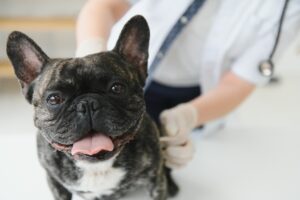Dogs are our loyal companions, always ready for playtime or snuggles. But with all that rolling in the grass and enthusiastic sniffing comes a need for some cleanup. “How often should I bathe my dog?” is a question on every loving pet parent’s mind. It’s more complex than you might think!
Beyond the Basics: Factors that Influence Bathing Frequency
- Coat Type: Is your dog’s coat short and sleek, or long and luxurious? Dogs with oily coats (like Basset Hounds) tend to get smelly faster and may need a bath more often than those with dry coats (like Chihuahuas). Double-coated breeds (like Huskies) should be bathed even less frequently to protect their natural insulating layers.
- Lifestyle: A dog who spends more time outdoors romping in the mud may need baths more often than an apartment pup who loves lounging on the couch.
- Skin Health: If your dog has allergies or sensitive skin, frequent baths can actually be irritating and worsen problems. However, medicated baths might be necessary in some cases. Veterinarian advice is key here!
- The Nose Knows: Ultimately, smell is your guide. When your dog starts to give off a distinct “doggy odor,” it’s bath time!
General Guidelines
While every dog is unique, here’s a starting point for bathing schedules:
- Most Dogs: Every 4-6 weeks provides a good balance between cleanliness and maintaining healthy skin oils.
- Oily Breeds: Every 2-4 weeks may be necessary to combat odor.
- Sensitive Skin: Stretch baths every 6-8 weeks, or even longer as tolerated.
Bathing Best Practices
Baths don’t have to be a battle! Make bath time positive with these tips:
- Start young: Puppies introduced to bathing early tend to tolerate it better.
- Prep is key: Brushing beforehand prevents mats and allows the shampoo to work more effectively.
- Lukewarm water: Too hot or too cold makes for a miserable doggy!
- Quality shampoo: Use a dog-specific shampoo designed for their coat and skin needs. Human shampoos are too harsh.
- Rinse thoroughly: Leftover shampoo residue can cause skin irritation.
Beyond the Bathtub: Maintaining a Clean Canine
Bathing isn’t the only part of good canine hygiene:
- Regular brushing: This removes dirt, distributes oils, and prevents matting, reducing the need for frequent baths.
- Ear cleaning: Regularly check your pup’s ears and clean them gently to prevent infections.
- Paw care: Wipe paws after walks to remove dirt and allergens. During winter, this helps prevent irritation from salt and ice melt.
- The occasional ‘freshen up’: Can’t fit in a full bath? ‘Spot clean’ problem areas with dog-safe cleansing wipes, or try a waterless foam shampoo for a quick refresh.
When to Consult the Vet: A Note of Caution
Sometimes, frequent bathing isn’t the answer. If your dog is itchy, has skin flakes, red spots, or continues to smell bad even after a bath, a visit to the vet is crucial. Skin issues can have a variety of causes and require tailored treatment.
Finding the Perfect Balance
Bathing your dog is about more than just getting them clean – it’s about their health and comfort. By understanding the factors influencing bathing frequency, and sticking to a schedule that suits your pup, you’ll create a happy and clean companion. After all, a good snuggle should always come without a side of doggy odor!
The Importance of Proper Drying
- Towel down: Start with a thorough towel dry to remove excess water, especially for thicker coats.
- Air dry vs. blow dryer: While air drying is often best to avoid skin irritation, some long-haired breeds benefit from a blow dryer in a low, cool setting. Make sure the air isn’t too hot, and never point it directly at their face.
- Preventing that wet dog smell: A damp coat can breed bacteria and lead to odor. Ensuring complete drying is essential for a fresh-smelling dog.
The Role of Diet and Supplements
- Healthy from the inside out: A balanced diet rich in essential fatty acids promotes healthy skin and coat, naturally reducing odor and potentially decreasing the need for frequent baths.
- Omega-3 Supplements: Consider adding fish oil or other omega-3 supplements to your dog’s diet for additional skin and coat support. Consult your vet for the appropriate dosage.
Specialized Considerations
- Wrinkly breeds: Dogs with skin folds (like Pugs or Bulldogs) require special attention. Clean the wrinkles regularly with a gentle cleanser to prevent yeast and bacterial infections, which can worsen odor.
- Working dogs: Dogs engaged in hunting, swimming, or other activities that lead to frequent dirt and debris may require more frequent bathing.
- Senior dogs: Older dogs may be less able to groom themselves effectively and might benefit from slightly more frequent baths to stay clean and comfortable.
Making Bath Time Fun (Or at least Tolerable!)
- Positive association: Treats, praise, and gentle handling make it a better experience for your dog.
- Non-slip surface: Place a mat or towel in the tub or sink to prevent slipping.
- Toys: A favorite chew toy can be a fun distraction during the bath.
Remember:
Every dog is an individual. Observe your dog’s coat condition, activity level, and smell to personalize their bathing schedule for optimal health and happiness!







